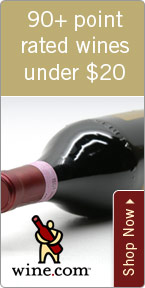That Champagne Time Of Year

Wednesday - December 02, 2005
| Share
 Del.icio.us
Del.icio.usAre you getting bubbly yet with excitement over the holidays?
And did you know that around 70 percent of all Champagne purchases are made in the month of December alone?
I drink Champagne throughout the year, but this is a special time when I know you are also thinking about what type of Champagne to drink for Christmas and the New Year’s celebration. So here is a short lesson in Champagne to help you to decide which one and which style is best for you.
Champagne must come from Champagne, France. You already knew that. Most Champagne is a blend of three grape varietals - Chardonnay, Pinot Noir and Pinot Meunier.
You’ll notice that the last two are actually black-skinned grapes. So how do they come out with a white wine?
They use a gentle and relatively quick pressing that does not allow the juice from the grapes to stay in contact with the skins, therefore not extracting any color from them. On the other hand, when they want to make Rose Champagne, all they have to do is leave the juice on the skins for a longer period or just blend the red wine with the white.
There are some Champagnes that use only Chardonnay. Those are called Blanc de Blanc, like Pierre Gimmonet’s Cuis Premier Cru. And there are others that only use the black grapes called Blanc des Noirs, like Bollinger’s Vieilles Vignes Francaises. The reason for blending comes from the old adage of creating something greater than the sum of its parts. Chardonnay gives a beautiful creaminess and texture to the wine. Pinot Meunier adds a lift of fruitiness and flowers. And Pinot Noir gives texture, backbone and richness. Think of it as a trio playing a piece of music instead of just a soloist.
Champagnes are also categorized according to dryness or sweetness levels. You will find them from driest to sweetest in this order: Brut Zero, Extra Brut, Brut, Extra Dry, Sec, Demi-Sec and Doux. The most popular and most available style is Brut, which is dry. Those of you who like it slightly sweeter will want to look for Extra Dry or DemiSec, like Moet et Chandon’s White Star or Veuve Clicquot’s Demi-Sec.
There are two different classifications for Champagnes. The first is Non-Vintage (NV) Champagne. This is a wine that is a blend of different vintages. They do this for consistent “house style” Champagne every year. It ensures that when you buy a bottle of this Champagne year after year, it will taste the same way it did when you had it before. This Champagne is not meant to be aged very long in your cellar.
It’s meant to be drunk soon after you purchase it. A good example would be the Louis Roederer Brut Premier.
The other classification is Vintage Champagne. This is the production of just one year. It is the expression of that year’s growing conditions. Champagne, being one of northerly growing districts in the world, is prone to inclement weather. So Vintage Champagnes are not made every year, usually they are produced only in great years.
These Champagnes will age and develop more complexity with cellaring. But remember, not everyone likes the taste of aged wines. I do, but you may not.
And lastly, there is a Champagne made by every producer that is called the Tete de Cuvee or Prestige Cuvee. It is their top-of-the-line wine. It is normally made with only the best grapes from the best sites within Champagne. It is also aged for a longer period of time in the cellars, so when it is released the wine has a tremendous complexity and offers an experience that cannot be found in any other bottle. These are the names that everyone wants to drink - Dom Perignon, Cristal, La Grande Dame, Cuvee Sir Winston Churchill and Fleur de Champagne. These are some of the greatest and most expensive Champagnes that you can find. If you’re trying to impress or really thank someone, these are the ones to get. They also offer pure hedonistic pleasure.
As you can see there is plenty to choose from, which is great. There is a style that can suit every person. No beverage is as linked to celebration and joy as Champagne. So pop a bottle of Champagne and get the party started.
As I’ve heard it said before, “May all your pain be Champagne.”
Cheers!
Recommendations:
1990 Krug Brut ($190): If you like Champagne, it’s worth it. It is truly one of the greatest Champagnes produced in the past 20 years.
1999 Perrier Jouet Fleur de Champagne Brut ($140): Buy it for the beautiful bottle. Or buy it because it’s delicious. Both ways, you win.
NV Pierre Peter Cuvee de Reserve Brut, Blanc de Blanc ($40): This is made from 100 percent Grand Cru Chardonnay grapes, creamy, succulent and vivacious. A delectable drink.
Roberto Viernes is a master sommelier. E-mail .(JavaScript must be enabled to view this email address)E-mail this story | Print this page | Comments (0) | Archive | RSS Comments (0) |
Most Recent Comment(s):












